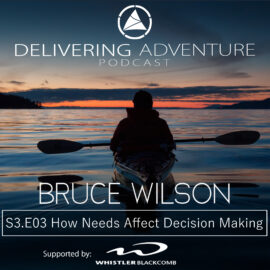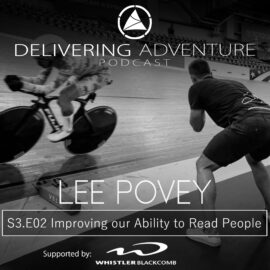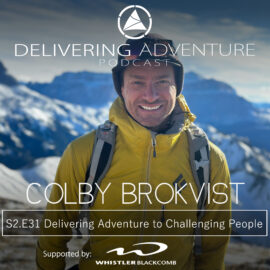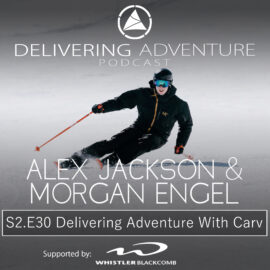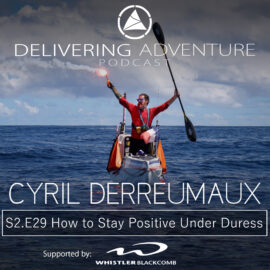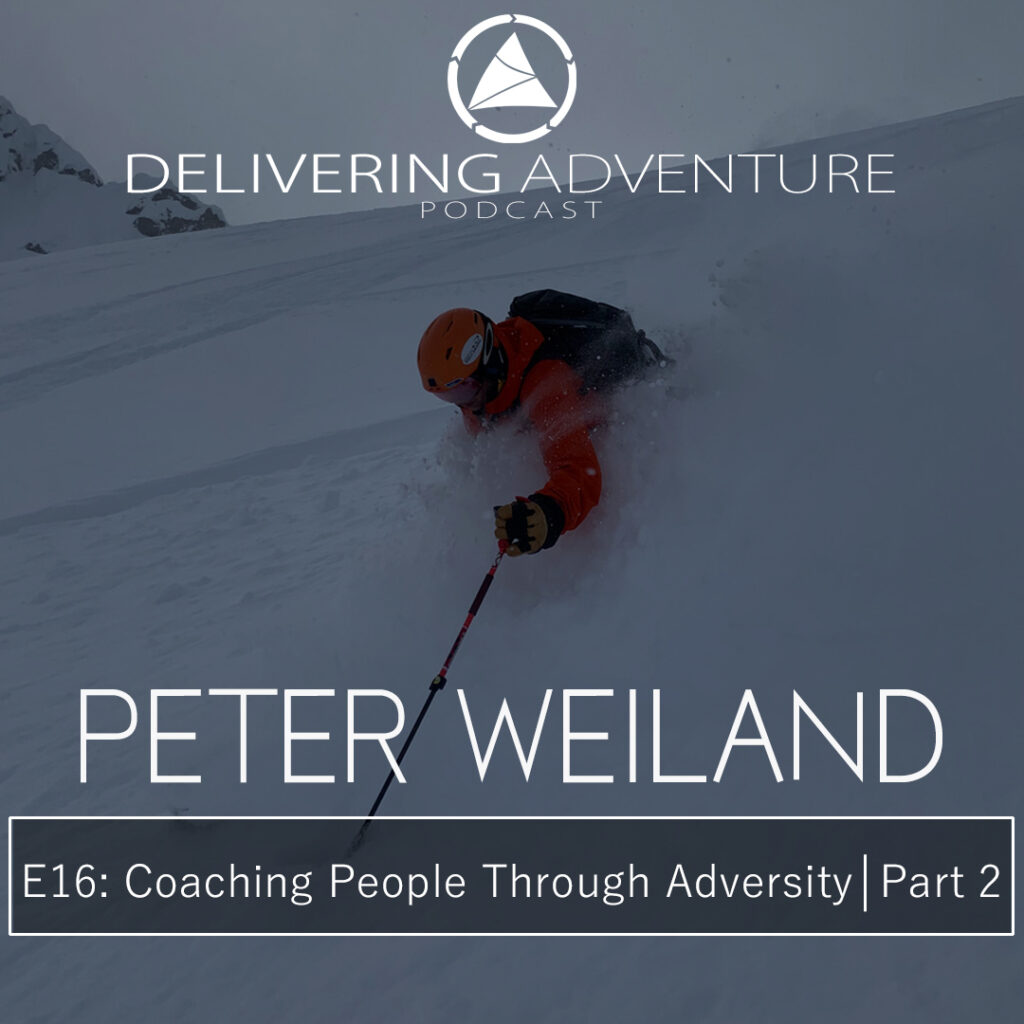
Coaching People Through Adversity – Part 2 with Peter Weiland
In this episode, we continue speaking with Peter Weiland on how we can help people to embrace adversity. Peter reveals some of his biggest challenges owning a bike tour company, some of the pressures of raising kids in a mountain resort town, his philosophy to coaching kids to play soccer, and the secrets to how to help people to push their limits.
Peter is a former semi-pro adventure racer, former owner of Rocky Mountain Cycle Tours and currently manages a youth soccer program. Peter is also a ski instructor at Whistler Blackcomb.
Key Takeaways
The value of having a sense of humor: Having a sense of humor can really help us to power through difficult moments.
Getting people through adversity can involve setting small milestones: Nothing builds confidence like success and sometimes people need small successes. This applies to finishing long journeys and learning new skills.
Kids and not pushing them:. Everyone has a limit, for kids that limit is lower. Just because someone can do something doesn’t mean they will enjoy it. Just because they can finish something doesn’t mean they will want to do it again
Just Recognizing the value of adversity and communicating it: Sometimes, just letting people know that what they are doing is hard – while reminding them that it will be worth it – can be enough to help them to keep going.
Guest Link
You can find Rocky Mountain Cycle Tours here: https://rockymountaincycle.com/
Follow or Subscribe
Liked the show? Remember to follow or subscribe!
Share & Social Links
https://linktr.ee/deliveringadventureT
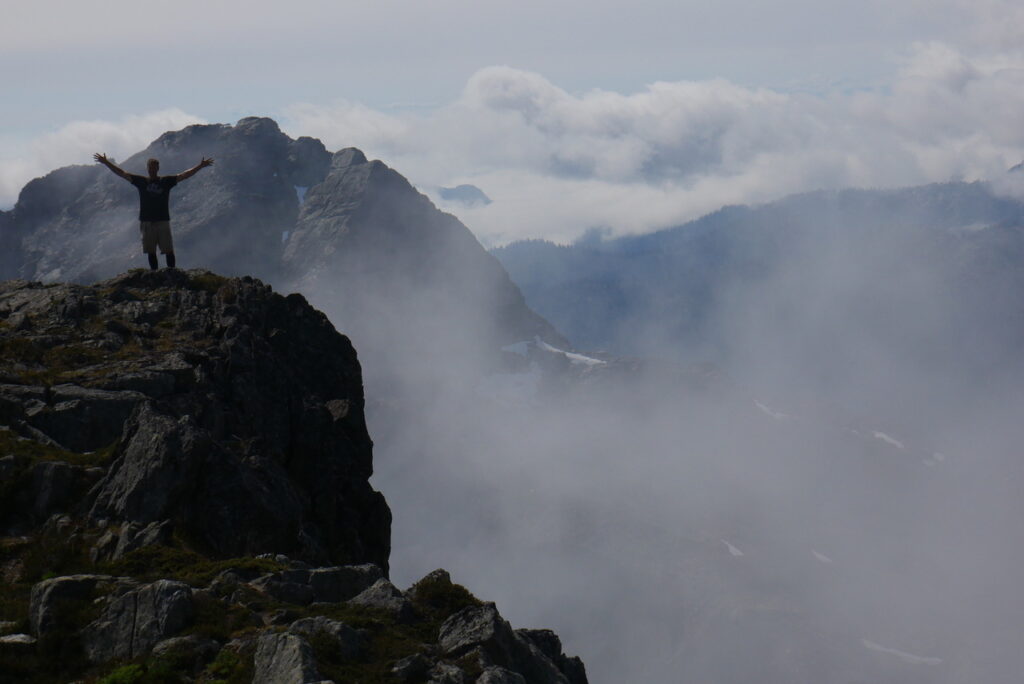
Episode Transcript
[00:00:00] Peter Weiland: But we had one person that I remember in Jasper, she told me, Peter, I’ve, I’m very fit, but I’ve never been on a bike that moves. I’ve only been on a spin bike and a New York gym. And so, I, I literally taught her how to ride a bike that moves forward in the Jasper Tall Park parking lot, right? Went back in, made sure that she had signed all the waivers,
[00:00:28] Chris Kaipio: This is Delivering Adventure. Welcome to the podcast that explores what it really takes to share adventure like a pro with your friends, your family, and as a profession. My name is Chris Kaipio, and I’m coming to you from Whistler, British Columbia.
[00:00:48] Jordy Shepherd: And I’m Jordy Shepard, recording from Canmore, Alberta. After a lifetime of working extensively in different parts of the adventure guiding industry, Chris and I have teamed up to launch this podcast.
In each episode, you’ll hear top adventure guides, managers, marketers, and athletes share their best stories, advice, and trade secrets. The goal of this podcast is to share how you can take yourself and others farther from the mountains to the office and. In this episode, we continue speaking with Peter Weiland on how we can help people to embrace adversity.
If you missed the last episode, Peter is an ex-semipro adventure racer and the former owner of Rocky Mountain Cycle Tours. Peter currently serves as a technical director for the youth soccer program in Squamish, BC where he lives with his family. In recent years, Peter has helped to grow that program to over 700 kids, which is an amazing.
This is the second part of a two-part series, as Peter had a lot to share with us and we decided to break it into two episodes. Here we go with part two.
[00:01:52] Chris Kaipio: So, Peter, fast forwarding, uh, a few years, you know, you’ve got Rocky Mountain Cycle Tours. Um, what were some of the challenges you faced running the company?
[00:02:05] Peter Weiland: Um, one year we were just going quite well. Um, and numbers were growing every year and uh, I’m not sure if you guys remember, there was another little virus, it was called SARS, right? Um, it wasn’t quite as bad as Covid, but it did put a quite a dent into adventure travel that year. And because, uh, I think it was mostly in eastern Canada, but um, Canada was on the list of countries.
Too great to travel. So initially we got a lot of people not signing up, and when you have weeklong trips and not a day trip business, you’re all dependent on, on numbers that, because people don’t make up their mind. Um, well I’ll go on a weeklong bike trip to the Rockies tomorrow. Right? So, it’s mostly pre bookings and um, so we find that year quite, quite difficult.
So, there was, um, yeah, outside circumstances, uh, that just. Happened. And then, um, I guess when, when you grow a tour company that started with something you’re really passionate about and you guide a lot of the tours yourself, which is why you initially got into it, um, as it grows to a size that it can feed your family and you can send your kids to college, it becomes more like the normal desk job.
Um, initially you may have tried to avoid by starting an adventure touring business, right? So, you find yourself doing a lot of admin stuff, um, dealing with regulations and parks and, um, doing payroll and, um, Uh, HOA stuff, uh, or yeah. And so, it, it becomes like a normal office job more and more. Um, plus the risks involved in, in having an adventure to a company.
And I think, Chris, you might remember when, um, when our trailer disappeared with guests ready to go, those are the moments when you really doubt why, why did I get into this right? Um, trailer full of camping gear for 12 people. All the food in there, all the um, all the, uh, camping equipment and yeah, there’s just not plan B, right?
For that moment.
[00:04:25] Chris Kaipio: I know I, uh, actually got to the point where I had to tell Peter, you know, if I called him, I had to, I had to start the conversation by saying, it’s okay, Peter. Nothing’s gone wrong. I’m just calling to say hello. Yeah, I think, I think it got to the point where Peter was always thinking like, oh my God, what’s next?
[00:04:45] Peter Weiland: And it was, uh, I mean, there weren’t too many incidents like that, but you. Feel like, wow, what could be next? Right. And so, I actually had, uh, for, for our guides, I had a different ringtone on my phone so that I wouldn’t just jerk up every time someone rang me on Sunday or Saturday. And, uh, so yeah, that, that worked better than
[00:05:10] Chris Kaipio: So, when you look back now, what are some of the successes that came from running the company that you’re the proudest of?
[00:05:20] Peter Weiland: Fairly early on we got, um, we got some really good writeups in magazine. The trips were rated in outdoor, no, what was it? Um, was it Outdoor Magazine at that time? I believe. So, they rated our trip as one of the top 20 adventure trips, um, in, in the world, uh, the, the Ice Hit Parkway bike tour. And, uh, so those were good successes.
We got some really good media in in other places. Um, Germany initially, because I still had lots of connections there, um, from camera trophy in the media and so on. And then also just seeing it grow and, um, growing it to a point where it was, uh, viable and also viable to be sold on and, um, and um, and leaving a little bit of a financial legacy for our, our family.
Yeah. So, you sold
[00:06:19] Chris Kaipio: the company. What has happened to
[00:06:20] Peter Weiland: it? Uh, one of our guides bought it, um, and, uh, he’s continuing to operate it, um, out of Canmore. So, he brought the company headquarters back home. This is, by the way, one of the biggest regrets I have being not in the Canadian Rockies, um, and running Rocky Mountain Cycle tours, but that’s a different story.
At the time, we felt, uh, we were not hard enough to live Camel Winter. That last eight months and you still have to wipe snow off your porch in June.
[00:06:56] Chris Kaipio: I think. I think Jordy knows all about
[00:06:58] Jordy Shepherd: that. Yeah. We often experience cooler temperatures here. It’s been interesting with climate change. I’ve noted in the Rockies here, there has been some short-term benefit, I think, of climate change. Mm-hmm, um, just with warmer temperatures, warmer evenings. But we know that it’s, uh, doing long.
Damage here to the, the glaciers and yeah, it’s not a, it’s not a good thing overall. Um, but kind of nice to sit on the back deck in the evening, uh, where we couldn’t a number of years ago. So, we’re talking about adversity still, um, in delivering adventure.
Do you think people need to be exposed to adversity or is it something that people should try to avoid?
[00:07:39] Peter Weiland: Well, I think I’ve personally, I’ve grown through adversity. You gain confidence that you can overcome it. You probably react calmer next time you face it. Um, so I think there’s a lot of positives to facing some sort of adversity. I think if it’s overwhelming all the time, then it’s not a good environment.
[00:08:03] Jordy Shepherd: Within reason.
[00:08:05] Peter Weiland: Yes. And I think the challenge is for if you put adventure products on the market to keep that level of adversity manageable and so that guests can have success. Right.
[00:08:18] Jordy Shepherd: But also not, uh, pamper folks along so that they never feel any adversity, discomfort, that sort of thing. Right. And there’s a difference between That’s right.
Yeah. Between discomfort that is, you know, kind of not part of the product that you’re looking for, um, as opposed to discomfort. That is, that is part of the product that you’re looking for.
[00:08:38] Peter Weiland: Yes. Yeah. And I guess the niche that we found for us as a tour company was, um, to offer a little bit more of those, uh, little less pampered and more personally challenging, um, cycling, uh, trips.
For example, we came up with the idea of. Uh, crossing the two mountain ranges in Canada in one cycling tour and making a thousand kilometers seven-day tour. Right. And it was actually surprising to see that there is a surprisingly large number of people who are thriving to face that adversity and, uh, and want to see if they can do this and, and then feel a tremendous sense of accomplishment in the end.
Right. And normally when you associate bicycle touring, you think back roads the. Pampered tour here out your left nostril is a bit moist. Can I wipe that for you? Right. And uh, and you see that bike’s more on top of the van than on the road. Sorry backwards for getting that slight instant
Um, so we, while we kept delivering a tour on the Icefields Parkway, that was doable for almost everyone. We also had our, we called it the Jasper Band 500, where you would do that trip in and ride 500 kilometers in five days because there is a large number of people who love Grand Fondos and who love, uh, riding back-to-back Grand Fondos.
And. And seeing if they can do it. Yeah. Yeah.
[00:10:04] Jordy Shepherd: And in that period of time, you know, five to seven days, you, you are more apt to, to have adversity in the weather as well, you know? That’s right. So that,
[00:10:13] Peter Weiland: that, that brings the adverse, the tour runs in any weather. Right. And yeah.
[00:10:17] Jordy Shepherd: Yeah. Yeah. It’s not like you’re just stopping and, and not, not carrying on the next day, so mm-hmm.
Except maybe when it snows 50 centimeters in July on the Ice Fields Parkway, you might shut her down for a bit.
[00:10:28] Peter Weiland: Right. We had that, not too often luckily, but it does happen.
[00:10:33] Jordy Shepherd: Yep. And then, yeah, hunker down in the tents and take a bit of time off, but that comes with, you know, that’s adversity, but it, uh, comes with, uh, part of the adventure side of things too, right.
Just mm-hmm, you just take, take what comes to you. So, you’ve had a number of, uh, physical and business challenges you have overcome in your, your career and, and time in business. And it seems that you tend to thrive on adversity and challenge. What’s your secret to managing yourself under physical and mental duress?
Like how do you keep yourself going, um, while you’re looking after others?
[00:11:09] Peter Weiland: Well, I think it’s, um, one step at a time. I think that was one of the mantras that I learned from some New Zealand is an adventure racing. It’s one foot in front of the other, uh, small little gold. And you can get to the finish line then, but don’t look at the finish line seven days away.
Just, uh, have small, achievable chunks and, and manage it that way. Um, if you just look at the finish line 500 kilometers away at the beginning of, of an eco-challenge, it can be overwhelming, right? Or can be overwhelming in the middle of the race when you’re just mentally drained and. Just want to cry when you, um, manage one kilometer per hour through slide outer and
[00:11:56] Jordy Shepherd: Yeah, I, I just listened to a podcast that I, I think it was Outside magazine and it was about crying, having a good cry out in the wilderness and during adventures and how that’s a different kind of crying than, you know, when you’re in a comfort level at home and having problems. Um, and sometimes you just got to have a little cry.
[00:12:18] Peter Weiland: Yeah. Yeah, definitely.
[00:12:22] Jordy Shepherd: And so, for that brings us to coaching others. Uh, you know, you might have some similar strategies to how you keep yourself moving along when there’s adversity. But, uh, yeah. Any, any tips, or tricks, uh, coaching points, uh, for helping others overcome their adversity while you’re delivering adventure?
[00:12:41] Peter Weiland: Yeah, I guess I can mostly look to the bike tours I guided is that, uh, again, look at, uh, progress in smaller chunks. Right? How about we make it to lunch now and uh, then we go from there, right? And often once they sat down, had lunch and little bit of food, and you, um, maybe feeling a bit warmer on a cold day because the sun now finally came out.
Um, The, the, the end point doesn’t seem so far away anymore. Right. Um, yeah, trying to keep in mind that there’s often no rainbow on the other side of the, of the dark clouds or the storm and, um, that you, you can get through this but chunk it in, in, uh, in smaller chunks and, yeah. Can we maybe push on just a little bit further?
[00:13:32] Jordy Shepherd: Right. And then decide, do, do you have any specific examples, uh, of that, um, you know, like from when you’ve actually like that that was sort of generalisms, but any specific examples that you’ve, you’ve experienced?
[00:13:45] Peter Weiland: Yeah, I think most of those examples would fall either into a bike tour or skiing where, um, I think, um, we’ve had many people who were in doubt after the first day that they could do, um, The whole Ice Field Parkway trip.
And so then again, we told them how would we try to chunk it, uh, section by section. Um, we, we always wanted to give our guests a chance to finish and not, um, at the first opportunity get their bikes on the van and drive to the next lodge. Right? Like some of the other, uh, operators like to do because it’s a lot easier for the guides.
If you can load, everyone can get everyone there, right? You. You, you chunk it, you, we tell them where, where the next stop is, where they can refuel a bit, um, how far it is from there. And often you see then after the first day or two, they see they’ve done this distance. They, they, they get a sense that they can actually accomplish the rest of it.
And, uh, I think in, in skiing it’s, um, it’s similar, building those skills step by step, uh, exposing them to shorter, steep runs that are very steep, but don’t look it, it’s completely different when you stand on top of a run that has, um, 2,500. Vertical feet vertical, and you look down and it’s a double black.
Then if that double black section is only 50 meters long, right? And then you can say, hey, we can ski this. Look, there’s an out on the side. Um, you, you get comfortable in short versions of a steep run and uh, you do that a couple times. You then go on a little longer one, and so you can build that, uh, resilience.
I also had a person once who. It was a good skier, but every time it looked steep, um, she had doubts and then started leaning to the mountain and everything went out the window. So, we skied her first black one in, in the thickest fog, you can imagine with her even not seeing the black sign. And she just did it perfectly right.
And then at the bottom, I showed her look as the black sign. You just skied a black run and you stuck to your technique. That was, I guess, the moment where she found some belief.
[00:16:12] Jordy Shepherd: Awesome. Have, have you ever had someone that you know, you, when you first got them, you know, into your trip, you know, it could be winter, it could be summer, uh, and you just think there’s, there’s going to be, uh, this is like a large adversity sandwich coming for them and with a side of adversity and.
And, uh, how, how is this going to go for them and, and how you sort of work them through that with, with, um, some modicum of
[00:16:41] Peter Weiland: success. Well, we had one person that I remember in Jasper, she told me, Peter, I’ve, I’m very fit, but I’ve never been on a bike that moves. I’ve only been on a spin bike in a New York gym, and so I, I literally taught her how to ride a bike that moves forward in the Japer hotel parking lot.
Right. I went back in, made sure that she had signed all the waivers, and then also made sure I wouldn’t ride. I did ride behind her initially, but I, she was weaving and wobbling initially quite a bit. I just couldn’t see it, so, but. She got fine. Right? It’s not that hard to ride a bike once you figure it out how it goes straight.
And yeah, we did have a few people who, um, were similarly less skilled bike riders. So, we had a few that actually requested to, um, to do the downhills in the van, which we don’t often get, right. So usually, some people take the van on the uphills, but, uh, did have the odd guests request a downhill shuttle from the Icefields Chalet.
[00:17:53] Jordy Shepherd: Yeah. Sometimes the downhill part is the most scary or most difficult thing. Right. But yeah, I hadn’t thought of that before. You know, if you’re running a bike tour that you might want to ask, do you know how to pedal and balance a bicycle? Right?
[00:18:08] Peter Weiland: Yes.
[00:18:09] Jordy Shepherd: She had the peddling down.
[00:18:10] Peter Weiland: Yeah. Mm-hmm.
Yeah, I think that’s the, we had one football player, 250 pounds, rode everything in, um, in track shorts, no padding underneath. I think he really suffered. He made it through, he rode in his track shorts and a t-shirt when it was sleeting on him, and he wasn’t the same where it was 30 degrees. But, uh, made it through and I think, but he took almost every daylight hour available
So, we, we had all the guests already at the lodge and circled back with the van and gave him support and everything. And, uh, yeah, when he was riding up to Dear Lodge that last steep bit until Lake Louise, it was, uh, hailing and I told him it’s only two and a half kilometers. And he said, and Peter, you’re not lying to me,
he couldn’t believe he was that close. Right? It’s a steep hill to finish with.
If you lie to me, I’ll be really angry, you don’t want to lie to a 250-pound football player, right? No. Keep it straight up. Same guy came with us again to Myer, but then he chose an E-bike there.
[00:19:26] Chris Kaipio: So, Peter, how do you balance pushing people without going too far? So, you know, I’ll give you an example. A few weeks ago, I was, guiding some school kids on a backpacking trip and they had not done that type of trip before.
And so, you know, we really worked hard to pace them and. You know, I think it was on day two, one of the teachers, you know, had said to us, you know, and this teacher ha was actually quite new to backpacking themselves. You know, they said to us, you know, wow, you should really, like, it would be really good if you could push the kids harder.
Um, you know, so that they can really test themselves and, and, um, you know, experience more adversity than, than they are. And from our perspective, we’re thinking, well, you know, the goal is to actually have them want to do this again instead of crushing them. So how do you balance, you know, pushing people without crossing the line and getting to that point where you know, they’re broken.
[00:20:31] Peter Weiland: I guess that’s a real challenge. Right. And uh, I think when I started out ski instructor in Whistler, I often wanted to show people that one more. Amazing run, which was mostly, would’ve been amazing for me, but they, they were already shot by that time, right? And, uh, so that run then was like four turns at a time.
And neither did I enjoy it, nor did they. Right. And so, it’s, um, I think trying to tune in where they’re at physically and, um, Asking the questions, helping them make assessments and um, see if they thirst for more than, than you do. Right? Because I think, as I said in the beginning, we all got into this because we are excited about doing back country skiing or riding bikes fast and so on.
And, um, but when you’re with the guests, you got to really ask yourself is. Best for the guests and help them make, make those, um, assessments as we go.
[00:21:39] Chris Kaipio: Yeah, I do, I do find that sometimes I have to remind people, you know, that this is supposed to be fun, you know, at some level, yes. This, this is actually supposed to be enjoying, you know, enjoyable and, and you should, you know, you should want to do this again as an instructor, you know, uh, teaching, you know, skiing often, I.
you’ll have parents or even, um, partners who are, you know, are thinking that, hey, you need to push the, the other person, you know, whether it’s a spouse or the kids, you know, harder and you have to kind of interject and say, listen, like they’re not going to enjoy that and they’re not going to want to do this again if we, if we push too hard.
[00:22:23] Peter Weiland: Yeah. With kids, there’s often the parents who want. To achieve a certain outcome with them. Right. When you’re skiing with some teenagers or kids, and the parents often push it more than, uh, the kids want to are ready for, right. Um, but I understand I have three kids on my own and probably with my oldest one made all the mistakes that, uh, Eager outdoorsy parents could make and try to push him really early into lots of skiing.
Um, took him up to Lake Lovely Water when he was three years old. It’s for those who know that hike, it’s grueling right to even to fit people. Um, I mean, I carried him half of the way, but um, uh, he’s the one of our family who likes skiing the least, and, uh, spends, I, I mean, he’s really passionate about his computer programming, but, uh, it does, it does take an exceptional, uh, deep part of Sunny day to get him on skis now.
Right. So, um, and uh, he’s probably the one. Has the least interest in outdoor sports or outdoor activities of our kids. And so, we grow up in these towns like Squamish, Whistler, camo is no different, right? Where, uh, you almost feel that social pressure, what your kid isn’t in ski school by three or is not in the Mountain Adventure program, and you feel as a parent are you a failure because you’re not, um, exposing them to that.
And so, with our kids two and three, we relaxed. On that quite a bit and realized that it was probably overdone it with Tom and I’ve, I mean with Tom, we’ve had numerous conversations about the topic. We now laugh it off, but, um, I, I think back to those mornings when I was in stress to get to ski school and had to drop him at, uh, at little kids at three years old Mondays and Wednesdays and was probably not a good experience for him.
Yeah. Sorry, can I say one more thing about. Kids because I, I think I should share that because it might help some other people avoid the same trap. Now, our some, number two, um, we didn’t put him in ski school at age three at all. Um, he, he went to ski school once a week when he was a four-year-old. And, uh, within two weeks he had learned everything.
A three-year-old had learned in one whole season. Right. Just because physical strength was so much. Uh, prevalent then already. And so, I really question that and I want to advise anyone to take it easy on their own kids and respect if they don’t want to, and, and don’t feel as excited about, uh, what you are feeling really excited about, right?
We want to expose them to many different things, but also leave them. Options and express their feelings and so on, on that.
[00:25:23] Jordy Shepherd: Yeah, I know what you’re talking about. Uh, for sure, Peter. Yeah. I’ve, I’ve, uh, made that same, uh, mistake myself. Yeah. Hmm.
[00:25:33] Peter Weiland: Yeah. So, you’re not alone like Facebook or your social groups is full of how young your kids have done some spearhead touring.
Right. And, um, so. I, I went up with Tom, the Spearhead Traverse, when he was 12. Right. And thought that it was a great experience for him, but likely it wasn’t, and it was only for me, like that moment. Wow. My son is amazing, right? He can do this at 12 years old. But he hasn’t been out there since then. Yeah.
[00:26:04] Jordy Shepherd: And then sometimes, you know, even if the parents are, you know, very experienced, active or their guides, instructors in an activity, it could, it could be worth it for you and for them to have them experience that with another person as well.
Absolutely. Yeah. You know, there’s a, uh, there used to be a sign at the Lake Louise Ski Hill. I don’t think it’s there anymore, but on, as you entered the lodge that said, uh, lake Louise Ski Hill, saving relationships since 1972 or whatever it was. I’ve seen that. Yeah. And it’s, it’s true, right? It’s sometimes best to have, you know, spouses, children, uh, cousins, aunts, uncles, maybe put them onto someone else for some of these experiences, at least early on.
Mm-hmm.
[00:26:48] Peter Weiland: Yeah. Or have other kids with them. Right, so they suffer together.
[00:26:54] Chris Kaipio: Yeah, exactly. So, it sounds like you’ve learned a lot, you know, raising your own kids. What kind of lessons have you been able to apply to running the soccer program then? I mean, you have 700 kids that you are, um, basically managing in, in your program in Squamish.
How has that, how, how has your own experiences affected, you know, your philosophy and, and your strategies?
[00:27:22] Peter Weiland: Oh, I could fill a whole podcast on that topic, Chris. Um, soccer as a sport has changed from when I played it in the seventies or eighties, where it was very physical running oriented. Now, uh, it’s so much more technical, right?
And, um, coaching, research and methodologies have involved so much that, uh, it’s all about, um, Creating age group appropriate, um, coaching sessions. And so, um, you don’t learn to read Shakespeare in grade one. And so, you don’t need to learn to play 11 aside soccer on a big field and taking headers, um, when you’re a six-year-old.
Right? But some parents still think when we play Sweet View without goalies on very small goals, that is not the real game. What are you doing here? Right? Um, but it is actually. Group appropriate steps. And so, um, my biggest mission that I’m on is, um, trying to coach our coaches to understand that we grow our kids, uh, step by step and we follow, um, curriculums that are working worldwide, right?
When you look at, um, how most kids in countries that. that are, have far less coaching resources than North America has. When you look at Brazilian kids or the kids in the projects in France who are probably the best soccer players in the world right now, they all grow up playing three V three four V, four Street soccer all day long because that is, they’re let out from an otherwise miserable.
Right. They’re often not exposed to coaches until they’re 12, 13, 14 years old and are already amazing footballers, and then they get a little bit of structure into their game. So, a lot of what we try to do is, um, for our younger kids to recreate the street soccer experience, um, where we. Coach relatively little and it’s a lot of play based and trying to make decisions and solve problems, um, without a coach telling you he had dribble from A to B pass, from cone A to C or dribble around these cones.
Everything needs to be decision based from, from a young age on, and we want to have them play in game-like environments where they constantly make decisions. North America. Produce a worldwide, uh, world class midfield player, which requires a lot of decision making and creativity in spite of throwing the most coaching resources at kids, because we, our coaches are often falling into the temptation of.
Trying to tell the kids everything they need to do. When you watch on a soccer sideline, it’s often pass, shoot, run here, right. And pass to Ollie and shoot. Right. So how can kids make their own decisions when the coaches are trying to make them all for themselves?
[00:30:21] Chris Kaipio: It, it sounds like you were watching my soccer games when I, when I was a kid growing up actually.
[00:30:26] Peter Weiland: All right. Yes. Well, mine were not that dissimilar. Yeah.
[00:30:32] Jordy Shepherd: Uh, maybe Peter, I’ll just ask you, uh, if there was one piece of equipment advice that you could give to, uh, to the audience, what would, what, what’s something that you generally just don’t go without, can’t, can’t do without, that you found really useful that you could pass on my phone,
[00:30:53] Peter Weiland: Keep track on Strava. If it’s not on Strava, it didn’t happen, right?
No. I think if I would go for any, um, any more serious backcountry, I would definitely have like a satellite way to communicate, um, like any of those devices that allow you to send message. Especially if you’re going for little solo missions. Um, I’ve done quite a few back country solos and they don’t seem far away, but, um, don’t be caught out without being able to communicate.
[00:31:34] Jordy Shepherd: Yeah, yeah. It doesn’t take much for even a very experienced person to have things go sideways and, uh, just having that, that life link out can make all the different, but you don’t want to do something over extreme just because you carry this then.
[00:31:43] Peter Weiland: Right. That’s the other trap that many people, I think fall into easily.
Um, because I think it’s just a phone call away. We can now go bananas. That’s the other side of technology, right?
[00:32:02] Jordy Shepherd: Yeah. It doesn’t prevent the slip or the, the slip, the fall, the overnight, uh, in bad weather that you’re not prepared for all that kind of stuff. You still. Be self-reliant out there.
[00:32:14] Peter Weiland: Yes. I’m still glad I have my compass and map skills because your GPS battery might run out.
Right. And I remember the first, uh, trip I did on the spearhead, um, spearhead Traverse was a three-day trip with some guys from the Alpine Club of Canada. And, uh, our GPS did not work properly and. White out for two days and, but we were able to do it with map and compass the old-fashioned way. Right. I’m glad for those volunteering, running, uh, clinics in high school that I had, that gave me a solid base for going in the back country.
[00:32:55] Jordy Shepherd: Yeah. And if you have a compass that’s got to fold up mirror on it, you can check that all your sunscreen is evenly applied to, so it’s got side benefit.
[00:33:05] Chris Kaipio: Great. Well, Peter, this has been, uh, this has been fantastic. Thanks so much for joining us today.
[00:33:10] Jordy Shepherd: Thanks for this, Peter. We’re going to let you go here.
All the best with your soccer program and future adventures. If you’re looking to find Peter, you can find him teaching skiing at the Whistler Black Home Snow School and working with the Squamish Youth Soccer Association. So, when it comes to helping people to embrace adversity, Chris, what were some of your key takeaways from what Peter had to share from this?
Well, Jordy
[00:33:32] Chris Kaipio: Peter had a lot to say, that’s for sure. Uh, there are two things that I’m going to highlight. People may not have picked up on, uh, that were definitely my takeaways. The first one is that running an adventure business is really hard. A lot of people over the years have asked me why I don’t run my own business, and having worked for a few people, including Peter, I can see why it’s super stressful the number of times.
I ended up calling Peter because we had some kind of an emergency, whether it’s the van breaking down or the trailer getting stolen, or there was a year once in 2013, uh, for our listeners in, uh, the Calgary area and Alberta area. You’ll know the giant flood that happened in 2013. Well, um, Jeanie and I were actually, we had a trip starting in Calgary.
On a Saturday and the flood happened Wednesday night and we were in Lake Louise, and we ended up having to drive all the way, almost all the way back to Vancouver from Lake Louise, and then all the way up to Jasper and then down. We actually didn’t even know if we could start the trip. And there was one, uh, section on, I remember Friday night, uh, Peter is like, should we just cancel the trip?
And we were in Kamloops, uh, BC at the time and we said, no, we can make it. And so, running your own business is full of adversity. Uh, and he did a great job, uh, uh, with that. And one of the things that helped him, is having a sense of humor. And that’s something that we often see with people that are dealing in, uh, with, uh, high stress situations, is that they often will, will make it through with that sense of humor.
And Peter, um, you can tell from his stories, he, he definitely found a lot of funny bits, uh, in them. Maybe not always in in the moment, but if you can find them in the moment, then um, you’ll reduce your own stress. Jordy, what stood out to you?
[00:35:24] Jordy Shepherd: Well, I agree, Chris, that having a sense of humor is critical and, and Peter really seems to be able to weather probably any storm that’s thrown at him just with his kind of dry European sense of humor that just, uh, you, you think he’s talking straight and then you realize, no, he’s actually having fun with you and he’s having fun with him.
So, some of my takeaways for getting people through adversity, it can involve setting small milestones, and that’s one of one of the points that Peter had. Nothing really builds confidence, like success, and sometimes people need small successes, and this applies to finishing long journeys and learning new skills.
Another takeaway was, for kids, uh, just don’t push them. Everyone has a limit. And for kids that limit is often quite a bit lower. Just because someone can do something doesn’t mean they will enjoy it, and you can really put them off pretty much forever, uh, quite easily at that stage in their life. And so just because they can finish something doesn’t really mean they will want to do it again.
I felt that way in ski racing when I was growing up in Jasper and it had to have some element of fun to it and kind of playfulness. Cause, otherwise, yeah, I just wouldn’t have stuck with it. You know, I’m not there doing that as a job. I’m doing it to have adventure and activity and feel fulfilled in my life at that point in my life.
And so otherwise I would not have carried on as long as I. And then just recognizing the value of adversity and communicating it. Sometimes letting people know that what they’re doing is hard, but it will be worth it. Just that alone can be enough to help keep them going.
[00:37:18] Chris Kaipio: Yeah, those are all great points Jordy. Now let’s turn it over to you, the listener. What were your takeaways? What stood out to you? You can share your thoughts story, your insights with us via our social media feeds, or by emailing us. You can find all of our contact information at deliveringadventure.com. Also, before you go, we need your help to keep this podcast going.
Please take a moment to share it with your social network. Adventure is best when it is shared. To finish off this episode, we have one last funny story from Peter
[00:37:58] Peter Weiland: Bruno. Woke up late that morning. It was his, uh, day to ride, and I had already done all the band check-ins, so I wasn’t ready. And so, he, he came running out when the group was ready to leave, basically, and, uh, didn’t have a cycling gear on.
So, I said, how about you start riding with them and um, and at the next stop you can put your cycling gear on. And um, so then he got his bike ready, but the guys were kind of impatient and left, and it was like a group of. Bikers and they were all decked out in the latest Lyra gear. Right. Or had all their own expensive $10,000 bikes with them.
And then, uh, as I pull by with the van, I see Bruno doing a fly by in a t-shirt and a baggy pant and in his flip flops, and it just flew by them. Right. And that was the talk of the trip for the end of it. They couldn’t just believe what they had seen. Right. Yeah. Bruno was a supremely fit. Um, adventure.
Personally, he the back country ski guide as well.


